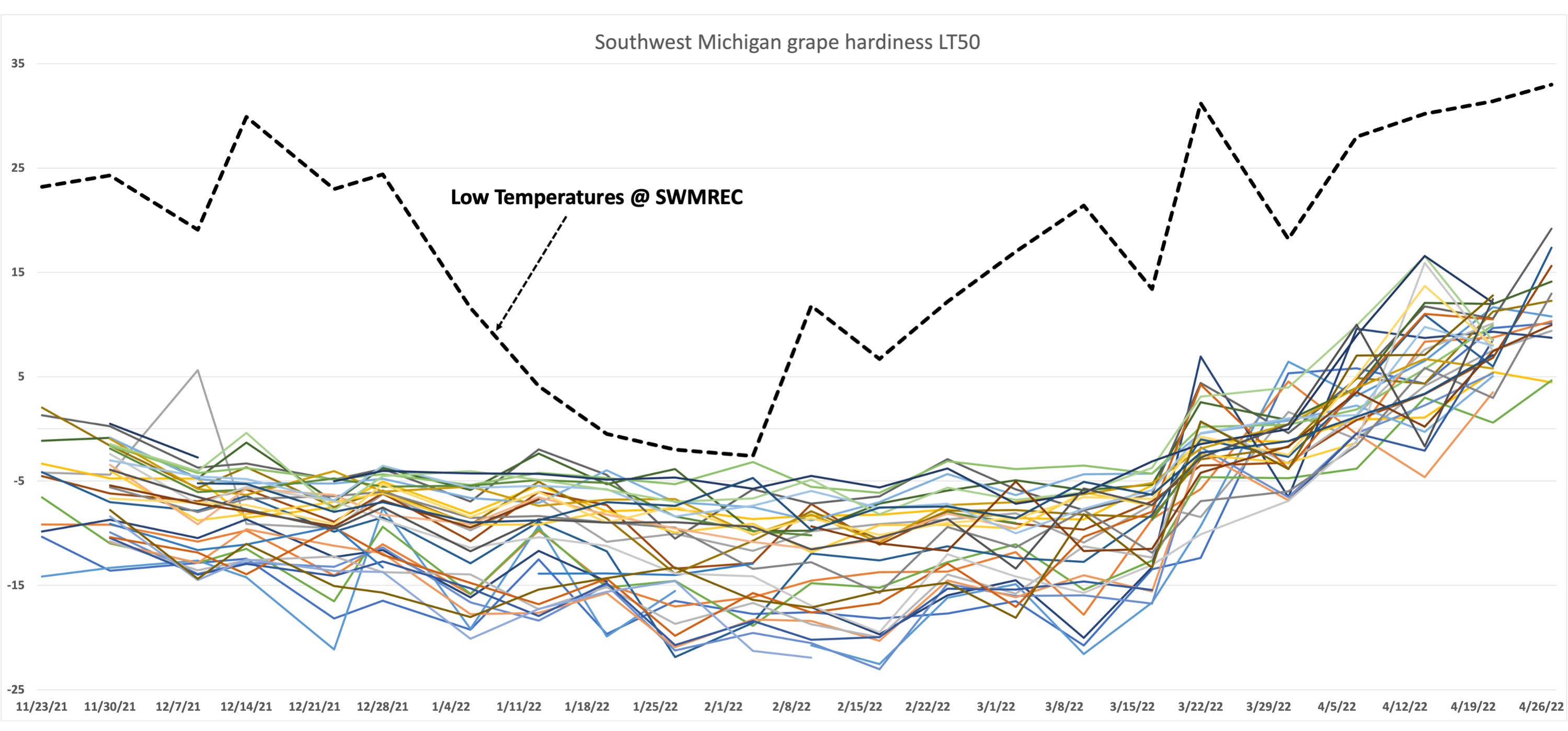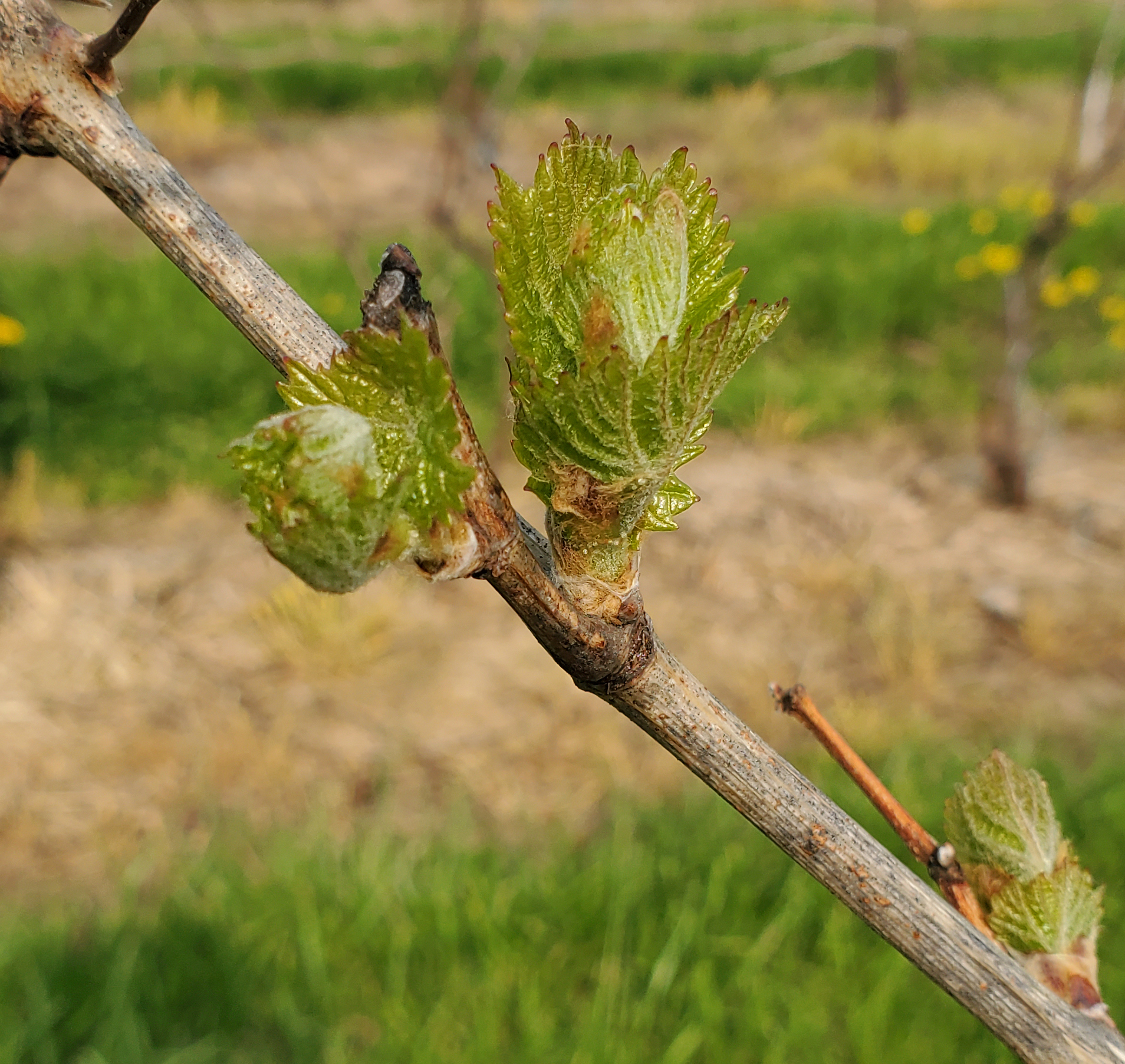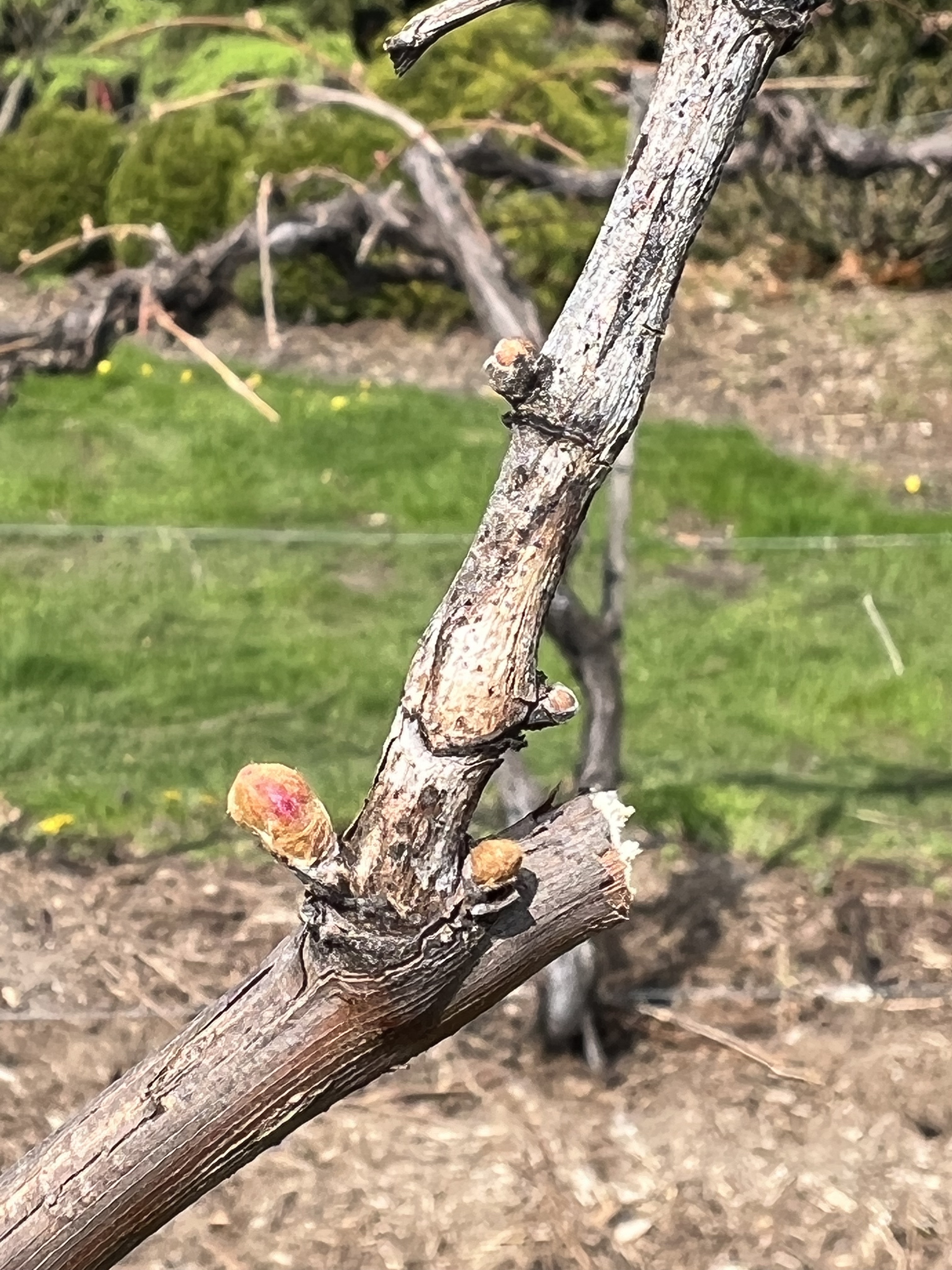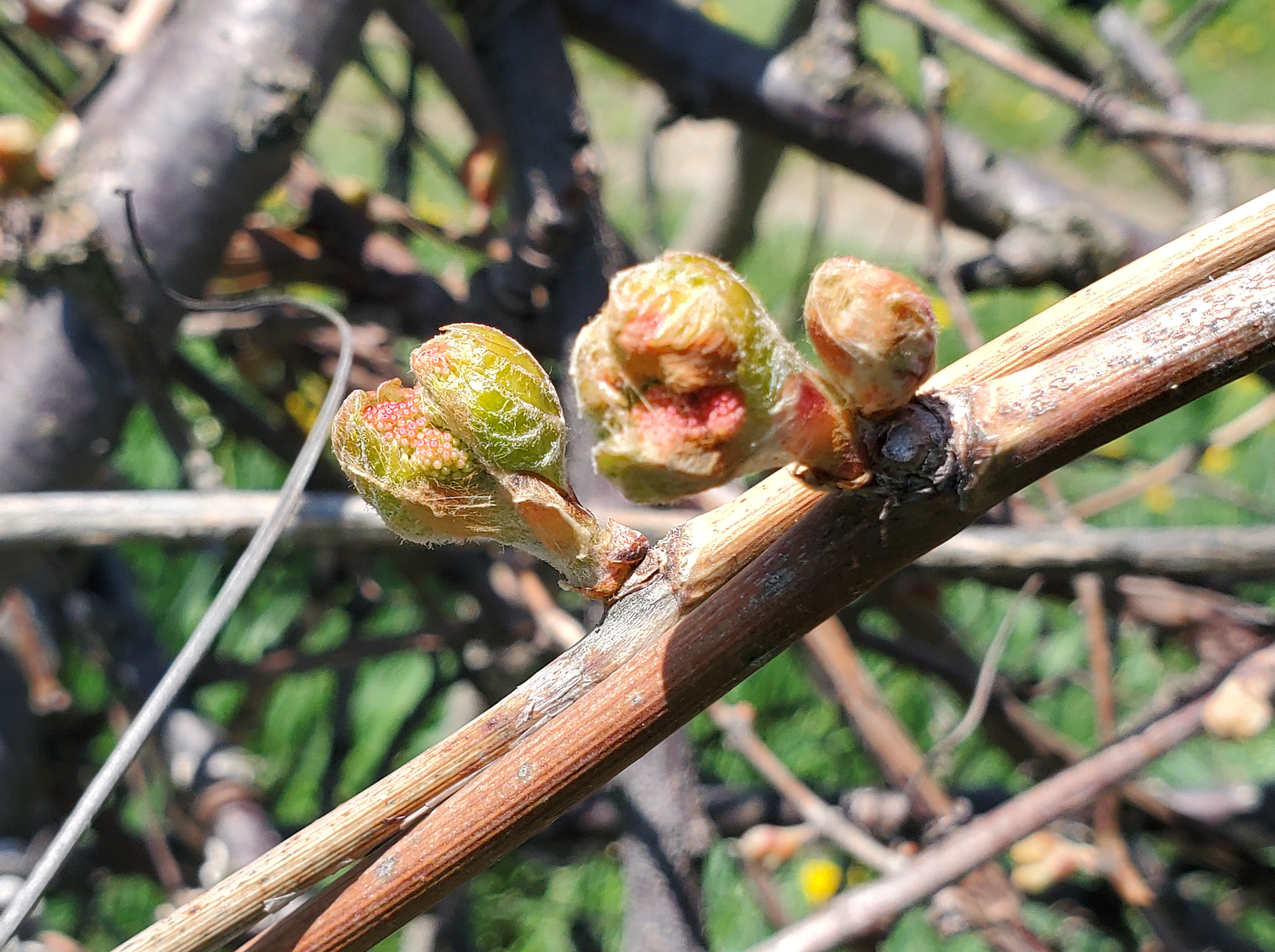Michigan grape scouting report – May 11, 2022
This is the first grape scouting report of the season.

The Michigan State University Extension grape team is starting its weekly scouting reports for 2022. This report will provide an update on weather and current grape phenology and discuss pest, disease, weed and horticultural conditions in Michigan’s major grape growing regions. We will also have updates on upcoming MSU Extension meetings for grape growers.
Sign up here to receive these weekly grape scouting reports (and other MSU Extension news as well) in your inbox.
Before we get into what’s happening this week, here is a quick review of conditions over the past six months.
Winter
The winter of 2021-2022 was mild for all of the major grape growing regions of Michigan. Temperatures rarely dropped below 10 degrees Fahrenheit. Everyone saw a couple nights just below zero. Southeastern Michigan saw the coldest weather with a freeze event in late January recording temperatures close to -10 F. No significant vine damage from these late winter cold events was reported. Winter precipitation was near average for the state. All five Michigan appellations are reporting minimal bud damage from the past winter.
The spring has generally been cold. Growing degree day (GDD) accumulations are behind the long-term average. Precipitation has been near normal for much of the state. Southwest Michigan is the wettest region. Soils are cool and wet. The heat this week should help dry them out.

Current weather
Last week saw a continuation of the cool spring. Highs at the start of the week were in the 50s with lows around 40 degrees in southern Michigan, a few degrees cooler in northern parts of the state. By the end of the weekend, temperatures were 10 F higher with northern Michigan warmer quicker than southern tiers. This was due to a rain system that passed through southern Michigan in the middle of the week. Rain amounts were a half to an inch and a half, depending on location.
This week will be the first hot week of the year. Statewide, we are expecting a few days in the mid 80s before dropping back down to typical temperatures by the weekend. There are chances of rain this coming weekend.
With the cool week, we picked up fewer than average number of GDD last week: 30-40 GDD base 50. The southwest region is 75 GDD base 50 ahead of the northwest region. Degree day accumulations will jump with the hot weather.
|
Southwest Michigan GDD Summary from March 1 through May 9, 2022 |
|||
|
Region |
Current GDD 50 F |
GDD 50 F last week |
Collected this week |
|
Southwest Michigan |
160 |
124 |
36 |
|
Southeast Michigan |
130 |
102 |
28 |
|
Northwest Michigan |
84 |
46 |
38 |
Vine growth
In the southwest, buds started swelling in the second half of April. Bud break in juice grapes and hybrid wine cultivars occurred around the first of May. With the cool start to May, development was slow, but some early vinifera cultivars have reached budbreak in the past week, notably Riesling and Pinot Noir are among the more advanced. This week, open leaves have been seen on Concord as well as Marquette and Geneva Red at the Southwest Michigan Research and Extension Center. With the warm weather this coming week, expect significant bud break in more vinifera cultivars and shoot growth in the advanced varieties.
In northern vineyards, most vinifera cultivars are at early bud swell. Bud break is expected this week with the warm weather forecasted.
See this chart for grape growth stages.
Horticulture
Fertilizer prices are high this year due to global supply chain issues. Accurate fertilizer application rates this year are important for the vines and the wallet. A quality soil test or a previous year’s petiole analysis is important in understanding what nutrients the vineyard needs. Early season nutrient management will most likely include nitrogen, zinc and boron. In addition, potassium and magnesium may also need to be managed at this time. Be careful with the amount of nitrogen applied in your vineyard. Too much can cause flowering to be delayed and vegetative growth to be accelerated. Too little will result in reduced vigor and less, lower quality fruit.
Shoot thinning will begin in the southern vineyards in a couple of weeks. Shoot thinning is an important canopy management tool to improve air circulation, minimize disease pressure, reduce shading, and improve spray penetration. Thin shoots when they are 5-12 inches long.

Diseases
At this time of year, the disease focus is on phomopsis, black rot, anthracnose and powdery mildew. Since we have had significantly warmer weather and a mild winter there is likely more spore dispersal occurring currently as well as a high amount of overwintering inoculum (on shoots, dried clusters and canes) that was not killed during a harsher winter. A dormant spray in the fall or spring can help to manage them before the season starts. Growers still have time to put dormant sprays on grapes in northern Michigan. Sulfur, lime sulfur and copper sprayed directly on the cordon are good dormant control options for these diseases. Copper can also help reduce downy mildew later in the season. Lime sulfur cannot be used once green tissue is present. Sulfur and copper can be used until leaves have opened. Make sure to use enough water for good coverage.
Once shoots have expanded contact fungicides that include broad-spectrum/contact fungicides like the EBDCs (FRAC M3) and captan are effective and function similar to dormant applications by sanitizing the vineyard before bloom. If a grower is organic, early season oils may also be used, which try to suffocate overwintering fungal spores and infected tissues. Be careful of utilizing oil applications within 14 days of any sulfur application due to phytotoxicity issues.
With the exception of powdery mildew, these spring disease infections typically require rain events. It only takes 0.1 inches of rain above 50 F to trigger a possible infection. Typically, DMIs (FRAC 3), captan and EBDCs (FRAC M3) are effective for phomopsis, black rot, anthracnose and downy mildew. If powdery mildew is the only concern, there are a number of products that are effective (FRAC codes 3, 7, 11, 13, 50, U6 and U13 as well as oils and sulfur). A combination of fungicides containing these FRAC classes should also be effective while helping with resistance management.

Insects
In southern Michigan, cutworm and flea beetle season is passing and vines will quickly grow out of the susceptible phase. Upcoming pests to look out for include rose chafer and potato leafhoppers in the coming weeks.
In northern Michigan, there is still time to get on delayed dormant sprays for scale and mealybugs if those were a problem last year. If you have had issues with grape erinium mite, a delayed dormant application of Envidor miticide was the most effective treatment in 2020 trials by MSU. Applications are most effective before there is any green tissue.
Male grape berry moth are starting to be caught in traps in southwest Michigan. With no clusters yet, there is zero risk from this pest at this time. Wild grape bloom is used as the biofix for grape berry moth models. Record the date when 50% of the clusters on wild grape are at 50% bloom. This date can be entered into the grape berry moth model in Enviroweather to predict when egg laying of the second generation will start. Wild grape clusters are starting to separate in some of the warmest areas of southwest Michigan, indicating bloom should be in a couple weeks, depending on how long the expected warm trend continues. Biofix for this insect has been around the last week of May or the first week of June for many parts of southwest Michigan in recent years.

This work is supported by the Crop Protection and Pest Management Program [grant no 2021-70006-35450] from the USDA National Institute of Food and Agriculture.



 Print
Print Email
Email




